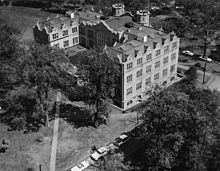Francis Furman
Francis Furman | |
|---|---|
| Born | 1816 |
| Died | 1899 |
| Resting place | Mount Olivet Cemetery |
| Nationality | American |
| Occupation | Businessman |
| Spouse | Mary J. Gilliam |
| Children | Charles Furman William G. Furman |
Francis Furman (1816–1899) was an American businessman in Nashville, Tennessee.
Early life
Francis Furman was born in 1816.[1]
Career
Furman was a successful dry goods merchant in Nashville, Tennessee.[2] In 1850, he was a partner in a dry goods store with R. C. McNairy and George S. Whitman called McNairy, Furman & Co.[3] By 1861, at the outset of the American Civil War, Furman dissolved his business, Furman & Co., which he co-owned with George Searight, James M. Goodloe, and Andrew Campbetl.[4]
After the war, he was the co-owner of Furman, Green & Co., another drygoods store with Frank W. Green, until 1869, when they closed down the business.[5] That same year, he opened another business on Cedar Street, Furman & Co.[5] A year later, in 1870, he renamed it Furman & Co. Wholesale Dry Goods and Notions, and move it to Nashville's Public Square, where it existed until 1890.[2]
Personal life
Furman was married to Irish-born Mary J. Gilliam (1828-1900).[1][2] They resided on North Cherry Street in Nashville.[6] In 1859, they had a son, Charles Furman, who died as an infant.[6] His funeral was conducted by Alexander Little Page Green.[6] Their second son, William G. Furman, was born in 1856 and died in 1900.[7]
Death and legacy
Furman died in 1899.[1] He was buried in the Mount Olivet Cemetery in Nashville, where his tomb was designed by Danish-born sculptor Johannes Gelert (1852-1923).[1][8] It is the largest tomb in the cemetery.[9]

Furman Hall on the campus of Vanderbilt University in Nashville is named in his honor.[2][10][11] It was the result of a US$100,000 donation by his widow after his death, even though he never attended the university.[2][11][12] Inside the building, there is a sculpture of Francis Furman.[2] From 1907 to 1967, it housed the Chemistry and Physics Department.[2][10][11] Since 1967, it has been home to the Humanities Department.[2][10][11]
References
- ^ a b c d FindAGrave: Francis Furman
- ^ a b c d e f g h Lewis, Princine (Fall 2010). "The Thief, the Pocket Watch, and the Dry Goods Merchant". Vanderbilt Magazine. Nashville, Tennessee. Retrieved September 22, 2015.
- ^ "R. C. McNairy". Republican Banner. Nashville, Tennessee. February 11, 1850. p. 3. Retrieved September 22, 2015 – via Newspapers.com.

- ^ "Notice". Daily Nashville Patriot. December 17, 1861. p. 1. Retrieved September 22, 2015 – via Newspapers.com.

- ^ a b "Dissolution". Nashville Union and American. August 10, 1869. p. 2. Retrieved September 22, 2015 – via Newspapers.com.

- ^ a b c "DEATH NOTICES FROM THE NASHVILLE REPUBLICAN BANNER FOR 1859". The Nashville City Cemetery. Retrieved September 22, 2015.
- ^ Findagrave: William G. Furman
- ^ Mount Olivet Cemetery tomb
- ^ Kreyling, Christine (August 9, 2007). "Six Feet Under: Nashville's cemeteries tell us as much about the living as they do about the dead". Nashville Scene. Nashville, Tennessee. Retrieved September 22, 2015.
- ^ a b c Nashville Public Library Digital Collections
- ^ a b c d Heard, Alexander G. (1995). Speaking of the University: Two Decades at Vanderbilt. Nashville, Tennessee: Vanderbilt University Press. p. 325. ISBN 0826512658.
- ^ McGraw, Robert A. (1978). The Vanderbilt Campus: A Pictorial History. Nashville, Tennessee: Vanderbilt University Press. p. 60. ISBN 9780585131832.
External links
Furman Hall statue by Johannes Gelert
